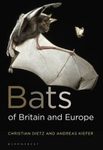Field / Identification Guide Identification Key
By: Loren K Ammerman(Author), Christine L Hice(Author), David J Schmidly(Author), Carson Brown(Illustrator), J Scott Altenbach(Illustrator)
305 pages, colour photos, ccolour & b/w illustrations, b/w distribution maps, 1 colour map, colour tables
![Bats of Texas Bats of Texas]()
Click to have a closer look
About this book
Customer reviews
Biography
Related titles
About this book
With all new illustrations, color photographs, revised species accounts, updated maps, and a sturdy flexible binding, this new edition of the authoritative guide to bats in Texas will serve as the field guide and all-around reference of choice for amateur naturalists as well as mammalogists, wildlife biologists, and professional conservationists.
Texas is home to all four families of bats that occur in the United States, including thirty-three species of these important yet increasingly threatened mammals. Although five species, each represented by a single specimen, may be regarded as vagrants, no other state has a bat fauna more diverse, from the state’s most common species, the Brazilian free-tailed bat, to the rare hairy-legged vampire.
The introductory chapter of this new edition of Bats of Texas surveys bats in general - their appearance, distribution, classification, evolution, biology, and life history - and discusses public health and bat conservation. An updated account for each species follows, with pictures by an outstanding nature photographer, distribution maps, and a thorough bibliography. Bats of Texas also features revised and illustrated dichotomous keys accompanied by gracefully detailed line drawings to aid in identification. A list of specimens examined is located at www.batsoftexas.com.
Customer Reviews
Biography
Loren K. Ammerman is an associate professor of biology at Angelo State University. Her PhD in biology is from the University of Texas at Austin. Christine L. Hice is a research assistant professor of biology at the University of New Mexico. She holds a PhD in zoology from Texas Tech University. David J. Schmidly is a prominent Texas mammalogist and author of the first edition of Bats of Texas (Texas A&M University Press, 1991). He currently serves as president of the University of New Mexico and was formerly president of Texas Tech University and Oklahoma State University.
Field / Identification Guide Identification Key
By: Loren K Ammerman(Author), Christine L Hice(Author), David J Schmidly(Author), Carson Brown(Illustrator), J Scott Altenbach(Illustrator)
305 pages, colour photos, ccolour & b/w illustrations, b/w distribution maps, 1 colour map, colour tables
"...this new edition of the authoritative guide to bats in Texas will serve as the field guide and all-around reference of choice for amateur naturalists as well as mammalogists, wildlife biologists, and professional conservationists."
- Ian "Birdbooker" Paulsen, Birdbooker Report









































